Mackay Mausoleum
Misc.
Born in Dublin, Ireland on November 28, 1831, the family of John Mackay soon after emigrated to the United States where young Mackay grew up in the New York City area. His working class roots instilled in him a drive and a work ethic that were instrumental in ultimately gaining him his vast fortune. Business acumen and duty to philanthropy are American traits driving development in the nation through the explosive late 1800’s.
- The Measure of a Man: John Mackay’s Early Years
- Gone But Not Forgotten: Life After Virginia City
- Green-Wood Cemetery
- The Mackay Legacy: The Mackay Mausoleum
The Measure of a Man: John Mackay’s Early Years
As noted by Douglas Keister, there are distinct parallels between the fictional family of the Cartwrights from television’s Bonanza and the life of John Mackay, a man who made his fortune in the same real-life town in which the program was set. While the Cartwright clan were ranchers in Virginia City, Nevada, Mackay, along with his business partners, enjoyed their own success when they discovered and developed a monumental deposit of silver ore in that little town in the northwest corner of the state.
In his adolescence, Mackay worked in a shipyard in his adopted home state of New York. Excited by the stories of riches to be made out west, at age 20 Mackay packed what little belongings he had and made his way to California. The tales of the Mother Lode were too intoxicating to ignore and Mackay was intent on carving his future out of the beneficent gold mines of Northern California.
Once in California, Mackay’s modest success did not live up to the dreams he had back east. News of the silver mines of northwest Nevada drove Mackay once again to pack up and relocate. What little money Mackay had earned in California was soon spent. Fortune smiled on the young Irishman in the form of his three new business partners, James Fair, James Flood, and William O’Brien. Their mining stock speculation and silver mine development soon yielded one of the largest ore body discoveries, forever after known as ‘The Big Bonanza.’ In 1873 dollars, the value of the discovery was estimated at $180 million. That equates to roughly $3.5 billion dollars today.
Gone But Not Forgotten: Life After Virginia City
After striking his complete financial independence in ‘The Big Bonanza’, Mackay eventually turned his attentions to other ventures and undertakings. In one such instance, he partnered with James Bennett in 1884 to form the Commercial Cable Company. They believed they could directly compete with Jay Gould’s Western Union Telegraph Company.
By the time he was well into his fifties, Mackay decided to expend more energy on leisure than on entrepreneurship. He traveled extensively, maintaining residences in London, Paris, and New York City. Despite this fact, Mackay always held a fond place in his heart for the little town that changed his life. He, therefore, supported a number of local charities, even bestowing a generous endowment to a Virginia City orphanage. The Mackay family largesse continued even after his death. In 1908 his widow, Marie Louise Hungerford Mackay, provided grant funding to the University of Nevada for the foundation of the Mackay School of Mines.
Green-Wood Cemetery
The Mackay family is interred at the Green-Wood Cemetery, noted as one of the first rural cemeteries in America. Located on 478 acres in Brooklyn, New York, Green-Wood is the final resting place for several noted individuals, including Leonard Bernstein, Jean Michel-Basquiat, and legendary New York City political chief Boss Tweed. Attracting as many as 500,000 visitors each year, Green-Wood was second only to Niagara Falls as the nation’s greatest tourist attraction.
Green-Wood, along with the Mount Auburn Cemetary located in Cambridge, Massachusetts, was one of the early influences on Frederick Law Olmsted for the design and creation of one of the most significant public spaces ever made, New York City’s Central Park. Olmsted realized the throngs of visitors each year to the park-like cemeteries exposed the need and desire of the public for grand, open spaces in the rapidly growing cities of the early and mid 1800’s.
The Mackay Legacy: The Mackay Mausoleum
The mausoleum in which the Mackay Family is interred draws its design influence from the Italian Renaissance Revival period. In 1898, the cost for constructing the grand facade was $250,000. The same structure today would cost upwards of $5 million, were there an artisans skilled enough to construct it.
The roof of the Mackay Mausoleum, at 26.5 feet square and 14 inches thick, accounts for the largest piece of stone ever quarried in the United States. The German-made bronze sculptures are life-sized representations of the allegorical figures meant to represent sorrow, faith, death, and life. These sizable figures are placed at each of the four corners of the impressive solid roof. Another unique feature of the turn-of-the-century mausoleum is that it was fitted with a heating system and electric lights that turn on only when the large bronze doors are opened.
John Mackay was a successful husband, father, industrialist, and philanthropist. The mausoleum that reflects his life’s work and passion is a fitting legacy for such an important figure of the mid- to late-1800’s.
Photos and text © Douglas Keister Visit Doug’s Author Page
[address cemetery=”Green-Wood Cemetery” street=”Willow Avenue” city=”Brooklyn” state=”New York” zip=”11218″]

